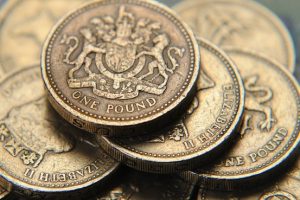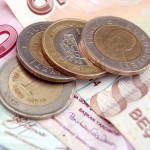 The pound retreated from more than a four-year high against the US dollar, after a report revealed the UK annual inflation rate unexpectedly fall below Bank of Englands target in January for the first time since November 2009.
The pound retreated from more than a four-year high against the US dollar, after a report revealed the UK annual inflation rate unexpectedly fall below Bank of Englands target in January for the first time since November 2009.
GBP/USD hit a session high at 1.6742 at 06:05 GMT, after which the pair erased daily gains to trade at 1.6699 at 11:08 GMT, losing 0.1% for the day. Support was likely to be received at February 14th low, 1.6645, while resistance was to be encountered at yesterdays daily high of 1.6823, also the pairs strongest since November 2009.
The UK Office for National Statistics reported today that UK annual inflation fell below Bank of Englands threshold for the first time since November 2009. The UK consumer prices rose 1.9% last month, compared to a year ago, short of analysts expectations for a 2% increase and after inflation fell to 2% in December, matching Bank of Englands threshold for the first time in four years.
On a monthly basis, consumer prices dropped 0.6% in January, while analysts projected a decline of 0.5% and after they increased 0.4% in the previous month.
Core CPI, which excludes the volatile food, energy, alcohol, and tobacco costs rose at an annualized rate of 1.6% in January, down from Decembers gain of 1.7% and short of analysts projections for a 1.7% advance.
However, data revealed that the retail price index rose by an annualized 2.8% last month, exceeding analysts estimates for a 2.7% advance and after a 2.7% increase in the preceding month.
The decline in the UK inflation will probably support Bank of Englands view, that there is still no imminent need to raise interest rates.
In its quarterly inflation report released on February 12, the central bank revised its forward guidance, replacing the 7% unemployment threshold with a range of economic indicators, including spare capacity.
BoE said the unemployment rate will probably fall below 7% in the first quarter of this year, but at the same time underscored there was “scope to absorb spare capacity further before raising bank rate” from the current record-low 0.5%. BoE estimated an output gap between 1% and 1.5% of UK gross domestic product.
According to policy maker David Miles, speaking two days before minutes of the Monetary Policy Committees meeting in February, there may be more spare capacity than BoE has initially estimated as the amount of slack is probably “toward the upper end” of the 1% to 1.5% of GDP.
“Inflation is not just at the target level but is likely to stay around that level for some time,” said David Miles yesterday, cited by Bloomberg. “If our best guess is that inflation will stay around the target level and there is slack, we would want to start using up that slack.”
The central bank raised its forecast for the UK economic growth in 2014 to 3.4% from 2.8% projected in November and predicted the first increase of interest rates will come in April 2015. Bank of England projected inflation of 1.9% in the next three years, below the central bank target of 2%.
Meanwhile, at 13:30 GMT the United States is to release the first indicator for nation’s manufacturing activity during the current month, the New York Empire Manufacturing Index. The median estimate of experts showed that the index probably slowed down to a reading of 9.50 in February after climbing to 12.51 in January, the highest since May 2012. Positive readings are indicative of expansion in activity.
The Federal Reserve Bank is scheduled to release the minutes of its January policy meeting tomorrow.
The central bank trimmed its monthly bond buying program from $85 billion to $65 billion after two $10 billion cuts. The Fed Chairman Janet Yellen cited the harsh winter and the unseasonably low temperatures as probable reasons for the weaker-than-expected US economic data, as the cold weather has affected activity in the labor market and elsewhere.
The Federal Reserve announced its latest decision to reduce monthly monetary stimulus by 10 billion USD to 65 billion USD at the meeting on policy in January, underscoring that labor market indicators, which “were mixed but on balance showed further improvement”, while nation’s economic growth has “picked up in recent quarters.” Fed policymakers are to hold their next meeting on March 18th-19th.
The Federal Reserve will probably continue to pare stimulus, which tends to devalue the greenback, by $10 billion at each policy meeting before exiting the program in December, according to a Bloomberg News survey of 41 economists, conducted on January 10th.
Elsewhere, USD/JPY hit a session high at 102.75 at 05:15 GMT, after which consolidation followed at 102.44, adding 0.5% for the day. Support was likely to be received at February 17th low, 101.39, while resistance was to be met at January 31st high, 102.94.





